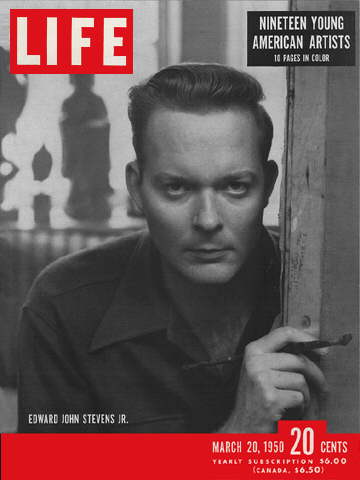|
Edward John Stevens, Jr. (1923-1988)
Critics have compared the work of Edward John Stevens with all types of primitive expression - Egyptian, Byzantine, African, American, Indian, Aztec.
The truth of the matter is that all these influences are indeed present, but in such a fleeting measure that it is impossible to seize upon any single one.
This remarkable fusing of manifold cultures, together with a sure sense of abstract design and gift for subtle color,
has brought recognition to the artist at a remarkable age.
Art News, February, 1946 |
||

|
Edward John Stevens, Jr, seen here at age 27 on the cover of Life magazine (Nineteen Young American Artists, March, 1950) had already been featured by the time this article appeared in six highly successful one-man shows at The Weyhe Gallery on Lexington Avenue in Manhattan, solo exhibitions at the Honolulu Academy of Art (1947) and the Baltimore Museum of Art (1948), and numerous museum group shows including installations at the Whitney, the Art Institute of Chicago, the Brooklyn Museum, and the Pennsylvania Academy of Fine Arts. By 1952 Stevens would sell over 600 works of art, and over the years paintings would enter the permanent collections of museums and such distinguished collectors as Joseph Hirshhorn - who acquired Stevens’ works in depth – and Roy Neuberger, and such celebrity patrons of the era as Gypsy Rose Lee, Kitty Carlisle Hart, and Ilka Chase. His style was analyzed, fellow artists Elaine de Kooning admired the eccentric embroidered effect of his brushwork (1949), Michael Lensen wrote of the golden threaded tapestry of his painting technique (1955).
An avid traveler, Stevens’ extraordinary oils and watercolors/gouaches were inspired by trips to exotic locales and a deep appreciation
for a wide range of artistic movements and ancient cultures - but whereas critics delighted in the anthropological references and cited the
influence of such artists as Klee, Braque and Chagall, Stevens’ own response was, I have produced the effect of archaic thought rather than
the symbols of a particular age or people. Noting an influence he would acknowledge, he advised his students, like Picasso says,
learn to draw and then forget it.
|
|